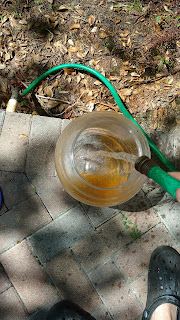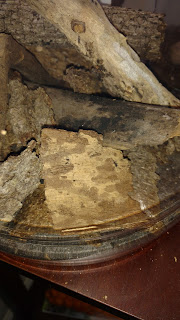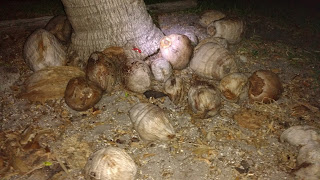It's time to get down to business and finally reveal the purpose of the blog. The the purpose of this blog is to spread the joys of keeping Periplaneta species, an often maligned roach species that actually needs some special accommodations in order to become a problem. Furthermore containing this genus is easy as far as roaches go, others being able to climb or squeeze through anything. And if they escape odds are high that even the adults will eventually perish in the house, unless you leave an open source of water and food available. Those people in tropical states will need to be more careful, but even in Florida, I've found that Periplaneta often were in very poor condition after a few days after wandering in from outside.
However if you want to enjoy these roaches as well, you will need a sturdy container, as I doubt you will find joy in having Periplaneta loose in the house.
A container such as this is perfect, even better if it has a screw on lid or held cheese balls. We will get to why shortly.
Next you will need to clean out the container, unless it was purchased empty.
I've found using a hose and dumping it out in the yard helps speed up the process, however there is nothing wrong with doing it indoors. Be sure to dry the sides, however do not scrub vigorously as we will want the oils from the cheese balls to act as a temporary barrier. However make sure the walls look clean.
Once it's cleaned it's time for the fun parts, finding decorations, or catching the roaches. Now if your purchasing your roaches it is wise to purchase your decorations to avoid the slightest possibility of infecting your roaches with some pathogens. However locally caught roaches can have decorations that you find in the wild. Cork bark is a great decoration as it has many holes in it for ooth depositing sites, if your looking for your own decorations make sure that they have many nooks and crannies.
That is a good example of a nice ooth laying site. Other decorations can include rocks, bark pieces, and other natural objects. Choose objects that can provide good hiding places.
These bark pieces offer good hiding places when placed upside down, making a makeshift shelter.
Once you find or buy what you need, the fun part of arranging the cage begins. There are a few things to consider however.
Take this various arrangement, there is one major flaw, one of the decorations is very high, allowing the roaches easier means to bypass the barrier and reach the top. Therefore you will want to rearrange things.
This is much better, the roaches can't reach the top and will be foiled by the barrier as well. The barrier can consist of petroleum jelly, or vegetable oil, canola oil, or olive oil. There are other more serious barriers, such as liquid Teflon, or fluon, but given the nature of these particular containers, especially those with a screw on lid such material is unnecessary. Place the barrier near the top of the container, taking advantage of the containers shape. Roaches will have further difficulties gripping a sloped surface, vs a vertical one. Only use a thin layer of petroleum jelly, as a super thick layer will actually allow smaller roaches to scale it. Be sure to reapply the barrier monthly. If your worried about escapes reapply weekly if you wish.
Another thing to consider is having a large flat piece of bark to serve as a food dish, of course there is nothing wrong with using an actual food dish.
This curved bark serves as the food dish. It is advisable to keep fruit, dry food, and water far apart in the enclosure if it is really humid, to slow down mold growth. Appropriate foods Periplaneta species are dog or cat food and fruits and vegetables. Fish and reptile foods are good alternatives.
Once the cage is ready the fun part begins, adding the roaches, if you purchased them then adding them will accompany little fanfare, however if you live where Periplaneta are common you can catch them yourself, as I did, and the feeling of accomplishment in catching impressive specimens adds to the fun of keeping Periplaneta, or roaches in general.
Your going to want to look for roaches in and around large pieces of bark, or other objects on the ground that provide shelter, it should be noted that Periplaneta don't often hide under objects that are flush with the ground. Night time, and hot and humid nights, with the temperature around 80 degrees Fahrenheit or higher are idea conditions. Also look after after rain showers. Placing bait such as dog food and fruits in likely locations will also increase your odds of finding roaches.
However finding them is only half of the battle, catching them is the second. We will get into that in the next post.
Hopefully you enjoyed reading this, and that it helps you get a good setup for your new Periplaneta.























